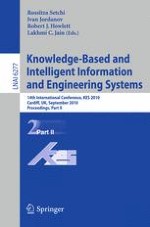th The 14 International Conference on Knowledge-Based and Intelligent Information and Engineering Systems was held during September 8–10, 2010 in Cardiff, UK. The conference was organized by the School of Engineering at Cardiff University, UK and KES International. KES2010 provided an international scientific forum for the presentation of the - sults of high-quality research on a broad range of intelligent systems topics. The c- ference attracted over 360 submissions from 42 countries and 6 continents: Argentina, Australia, Belgium, Brazil, Bulgaria, Canada, Chile, China, Croatia, Czech Republic, Denmark, Finland, France, Germany, Greece, Hong Kong ROC, Hungary, India, Iran, Ireland, Israel, Italy, Japan, Korea, Malaysia, Mexico, The Netherlands, New Zealand, Pakistan, Poland, Romania, Singapore, Slovenia, Spain, Sweden, Syria, Taiwan, - nisia, Turkey, UK, USA and Vietnam. The conference consisted of 6 keynote talks, 11 general tracks and 29 invited s- sions and workshops, on the applications and theory of intelligent systems and related areas. The distinguished keynote speakers were Christopher Bishop, UK, Nikola - sabov, New Zealand, Saeid Nahavandi, Australia, Tetsuo Sawaragi, Japan, Yuzuru Tanaka, Japan and Roger Whitaker, UK. Over 240 oral and poster presentations provided excellent opportunities for the presentation of interesting new research results and discussion about them, leading to knowledge transfer and generation of new ideas. Extended versions of selected papers were considered for publication in the Int- national Journal of Knowledge-Based and Intelligent Engineering Systems, Engine- ing Applications of Artificial Intelligence, Journal of Intelligent Manufacturing, and Neural Computing and Applications.
